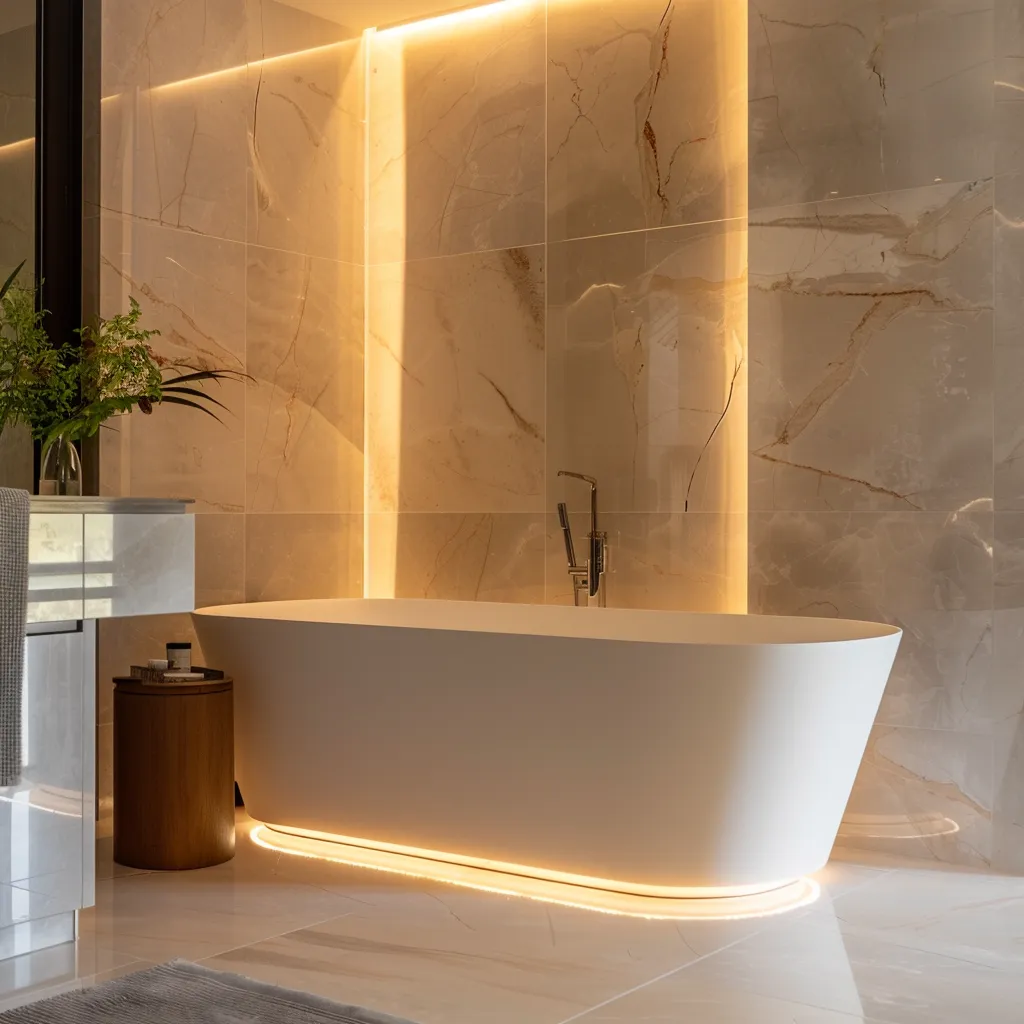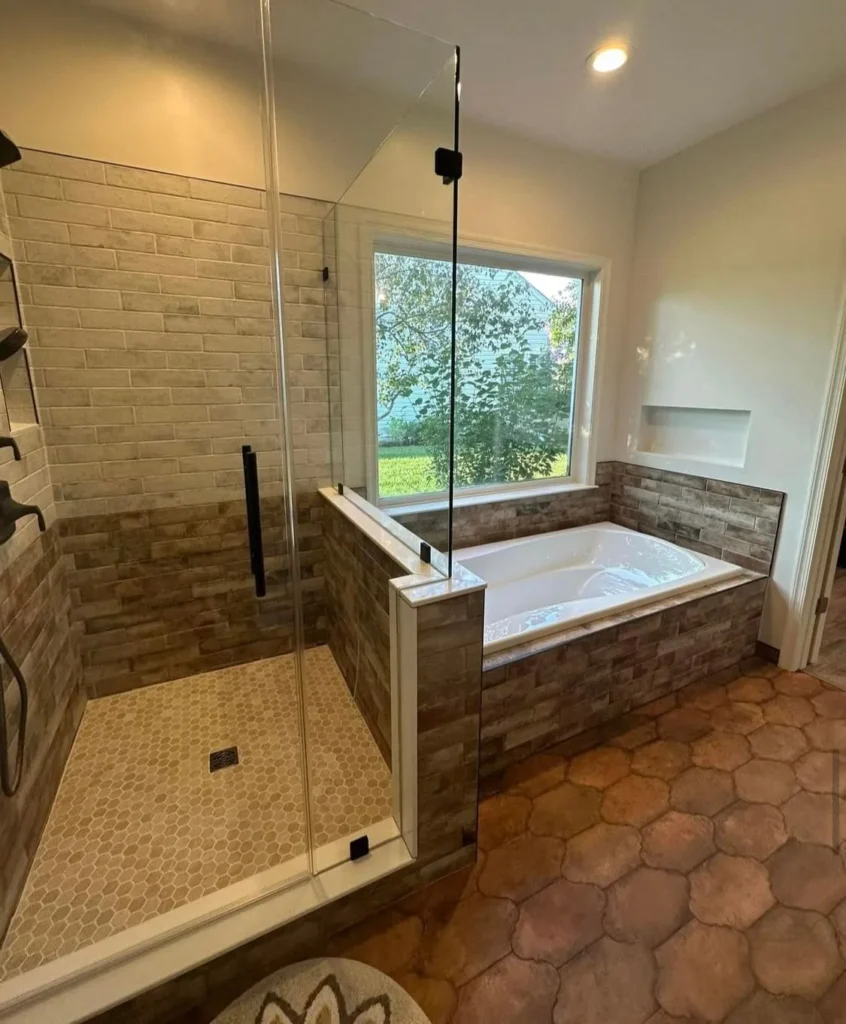
Elegant Bathroom Remodel Styles for the Year 2025
As we head into 2025, bathroom remodeling continues to lead home renovation trends, especially among homeowners along the coast and in regions facing severe weather conditions. These remodels are no longer just cosmetic updates—they’re thoughtful transformations that prioritize sustainability, smart technology, and practical functionality. Whether you’re updating a master bath or combining kitchen and bathroom renovations, knowing what’s trending and which materials and layouts perform best is essential to creating a space that’s as efficient as it is elegant.
This guide explores everything from streamlined design trends and contractor selection to energy-efficient upgrades and layout strategies. We’ll also touch on the importance of durable materials that withstand coastal climates and modern upgrades that reflect how bathrooms are evolving into high-tech wellness retreats. With insights from real-world remodeling examples and sustainability research, this comprehensive overview is your blueprint for executing a sophisticated and future-ready remodel.
2025’s Defining Bathroom Remodel Styles
The latest bathroom styles are more than just visually striking—they’re built around high performance, ease of maintenance, and eco-conscious living. These remodels focus on how people actually use their bathrooms and seek to blend comfort, aesthetics, and practicality into a cohesive design.
Innovative Materials for Long-Term Use
Durability is paramount in modern bathroom design. Engineered quartz, large-format porcelain tiles, and polished concrete have become top choices for surfaces, combining visual appeal with superior resistance to water and staining. These materials not only extend the life of vanities and flooring but also reduce the need for intensive maintenance. Reclaimed wood accents are also growing in popularity, bringing warmth and texture while supporting sustainable building practices.
Integrated features like underfloor heating and antimicrobial coatings further boost performance. For instance, self-healing grout prevents cracking, while stone countertops with embedded heating elements add a touch of luxury with energy efficiency in mind. These material choices allow homeowners to create spaces that are both inviting and resilient—especially important in climates prone to humidity or salt exposure.
Space-Saving Layouts That Flow
Today’s bathrooms are being reimagined for better flow and function. Open-concept designs with floating vanities, walk-in showers, and wall-mounted toilets eliminate clutter while making small spaces feel larger. Smart zoning—such as separating wet and dry areas—helps organize the space without relying on bulky dividers.
Planning software and 3D modeling tools allow homeowners to virtually design their layouts before construction begins. This tech-driven approach results in more accurate measurements, better material estimates, and more functional final designs. Especially in compact urban homes, these layouts can reclaim up to 20% more usable space through better organization and design foresight.
Smart Home Integration Takes Center Stage
Smart technology is redefining how we experience bathrooms. These integrations are no longer a novelty—they’re becoming essential for convenience, comfort, and efficiency.
Smart Showers and Connected Fixtures
From app-controlled water temperature to built-in audio systems, today’s showers offer a spa-like experience tailored to individual preferences. Some systems even recycle water, monitor consumption, and adjust temperature automatically. These upgrades are ideal for homeowners who want luxury without compromising on sustainability.
Smart mirrors are another major trend—complete with LED lighting, Bluetooth connectivity, and voice command features. These mirrors can display calendars, weather, or health data, blending function and form in a single sleek unit. According to industry studies, smart integrations can cut daily energy use by up to 15% while adding considerable resale value to a home.
Sensors and Leak Prevention
Touchless faucets, motion-activated lighting, and humidity-sensing fans are now standard in high-end remodels. These tools not only improve hygiene but also protect against moisture damage—a critical factor in coastal homes. Leak detectors and real-time alerts further minimize the risk of costly water damage, helping homeowners stay proactive with maintenance.
By pairing automation with thoughtful design, smart bathrooms are transforming into intuitive spaces that support wellness and energy savings alike.
The Sustainable Bathroom Revolution
Sustainability is not just a buzzword in 2025—it’s a driving force behind every major remodeling decision. The integration of eco-friendly plumbing and lighting solutions ensures long-term cost savings and reduces environmental impact.
Water-Saving Fixtures
Low-flow toilets, dual-flush systems, and sensor-operated faucets help cut water use without sacrificing performance. According to the Water Efficiency Council, homes that install these fixtures see a 40% reduction in water usage on average. Water-recycling systems for showers and sinks are also gaining traction, particularly in drought-prone areas.
Beyond just saving water, these features qualify many homeowners for local rebates or federal tax incentives—making sustainable upgrades financially smart as well as environmentally responsible.
Energy-Efficient Lighting and Heating
LED lighting systems remain the gold standard for energy efficiency. Today’s models are dimmable, color-tunable, and often integrated into mirrors, vanities, and ceilings. Motion sensors ensure lights are only active when needed, further reducing consumption.
Meanwhile, radiant floor heating powered by low-voltage systems offers comfortable warmth with minimal energy use. Pairing these upgrades with solar-powered ventilation or passive daylighting through skylights boosts both comfort and efficiency.
By focusing on sustainability from the ground up, bathroom remodels in 2025 not only reduce monthly utility bills—they support a healthier planet and a healthier home environment.
Modern Design Trends That Define the Look
Alongside performance improvements, bathroom remodels in 2025 embrace a refined visual style that blends minimalism with personalization. Today’s top design trends prove that elegance lies in simplicity—paired with standout features that make the space feel unique.
Minimalist Geometry and Natural Palettes
The minimalist movement continues to gain traction, with homeowners opting for clean lines, seamless surfaces, and open layouts. Neutral color schemes—particularly whites, grays, taupe, and earth tones—create a calming atmosphere and allow materials like stone and wood to stand out.
Geometric tile patterns, curved hardware, and frameless glass enclosures enhance the visual clarity of the space. This approach reduces visual noise and makes bathrooms feel larger and more tranquil—ideal for those seeking a spa-like escape at home.
Statement Fixtures and Textural Contrast
While minimalism dominates, designers are also leaning into bold statement pieces to add personality. Freestanding tubs, matte black faucets, and textured sinks made of concrete or hammered metal offer focal points that elevate the overall design.
Mirrors with built-in touch controls and anti-fog capabilities serve both form and function, while sculptural lighting fixtures add sophistication. Customization options abound—homeowners can select finishes, shapes, and layouts that reflect their personal style while staying on trend.
Integrated Storage for a Seamless Look
Storage remains a critical component of modern bathroom design. Built-in shelving, recessed cabinets, and floating vanities offer functional storage without disrupting the clean aesthetic. Many homeowners are choosing modular solutions that can evolve with their needs.
Features like soft-close drawers, built-in organizers, and illuminated compartments enhance usability. These smart storage choices reduce clutter while maintaining a polished look, proving that practical doesn’t have to mean plain.

Essential Planning Considerations
Executing a successful bathroom remodel requires more than just a vision—it demands strategic planning, budget discipline, and expert guidance. By addressing these elements early, homeowners can avoid delays and maximize their investment.
Smart Layout Planning
The bathroom’s layout affects everything from comfort to efficiency. A well-planned design should support daily routines while maximizing space and accessibility. Popular layout upgrades include converting bathtubs to walk-in showers and creating separate zones for wet and dry activities.
Accessibility is also a growing concern. Many remodels now include future-proof features such as wider doorways, curbless showers, and grab bars—especially in multi-generational homes. These additions can be seamlessly integrated into modern designs without looking clinical.
Coordinating Budget with Material and Labor Costs
Every remodel should start with a clear and realistic budget. Break costs down into categories—materials, labor, permits, and contingencies—and account for potential upgrades along the way. Homeowners often underestimate the cost of installation, so partnering with an experienced contractor is key.
Comparing options—like quartz versus marble, or prefab vanities versus custom cabinetry—helps keep the project on budget without sacrificing quality. Tracking expenses through a spreadsheet or project management app ensures financial control throughout the renovation process.
Energy-Efficient Investments That Pay Off
Spending a bit more upfront on energy-efficient fixtures, smart technology, or sustainable materials can lead to lower operating costs and higher property values. Federal tax credits and state rebates often apply to green upgrades, making these investments even more appealing.
Whether it’s a water-saving toilet, an ENERGY STAR-rated ventilation fan, or motion-activated lighting, the savings add up—both financially and environmentally. These decisions make remodels smarter, more sustainable, and more attractive to future buyers.
Frequently Asked Questions
What are the key trends in 2025 bathroom remodels? Trends include smart home integrations, open-concept layouts, sustainable fixtures, minimalist designs, and durable material choices like quartz and concrete.
How do I choose the best contractor for my project? Look for licensed professionals with strong portfolios, verified references, and positive reviews. Meet with multiple candidates and choose someone who communicates clearly and understands your vision.
What design features improve space usability? Floating vanities, walk-in showers, recessed storage, and strategic zoning all enhance usability while keeping the space visually open and functional.
Why are sustainable features important in bathroom remodels? Sustainable plumbing and lighting reduce utility bills, conserve natural resources, and often qualify for rebates—making them smart investments for both the environment and your wallet.
How does smart technology improve the bathroom experience? Smart mirrors, touchless faucets, and app-controlled showers improve comfort, save energy, and allow for personalization, creating a more efficient and enjoyable daily routine.
Bathroom remodels in 2025 represent a confluence of elegance, innovation, and practicality. With modern materials, smart features, and sustainable solutions, homeowners can create spaces that serve both their immediate lifestyle needs and long-term property goals. Whether you’re renovating for comfort, resale, or environmental responsibility, these trends offer a clear path to a better bathroom—and a better home. For more ideas and professional support, visit procoast.net for a free quote. Your dream bathroom is just a well-planned renovation away.